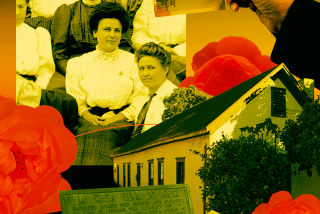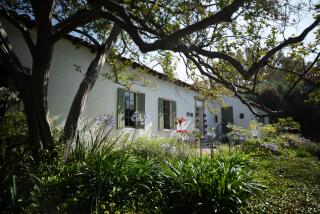Dig Finds Pieces of Lives From Earliest Days of Presidio
- Share via
SAN FRANCISCO — When Barbara Voss saw the jagged rocks, she didn’t know what she was looking at. The year was 1993, and Voss, a private archeological consultant working for the Army, was supervising removal of a fuel storage tank on the main post of the Presidio, the historic military base situated on the far north end of the city.
As backhoes removed the tank--located next to a stately row of 19th century officers’ houses--the soil fell away from the walls of the pit, revealing a cluster of sharp-edged rocks. “We knew it was something very special,” Voss remembers, “but we had no idea what.”
It turned out to be part of a foundation from the original Presidio, established in 1776 by the Spanish military. In one of those quirks of fate that gratify historians, Voss--who with other consultants oversaw the environmental cleanup of the Presidio in preparation for its transfer to civilian oversight--had stumbled upon its earliest remains. Helping the Presidio face its future, workers had inadvertently uncovered its most distant past.
And Voss had discovered a vocation. Now a doctoral student in archeology at UC Berkeley, she is helping supervise an excavation at the Presidio that has unearthed artifacts going back three centuries, to the earliest days of the Spanish outpost. The excavations, which are open to public view, continue this summer on the Presidio’s main post.
In her imagination, Voss can see the Presidio as it once must have looked: a lonely row of adobe houses sitting on a sandy, wind-swept promontory, capped by orange-red roof tiles. Smoke pouring from their chimneys, they seem to huddle against the cold, their walls forming a rectangular central plaza, a sanctuary against the elements.
This was the Presidio of the early 1800s, the farthest outpost of the Spanish colonial empire, a garrison hung out at the edge of the known world. It’s a Presidio that still exists, hidden in the ground, suspended in layers of clay and earth.
Though the probable location of the original Spanish quadrangle had been deduced by historians, it wasn’t until 1993 that its physical remains were discovered. Now, as if opening a child’s pop-up book, Voss and her team of volunteers are trying to reconstruct the living, three-dimensional aspects of a building that lies squashed flat under several feet of ground.
Nearby, her associate and fellow UC graduate student Amy Ramsay is overseeing a separate dig of the American quarters, built during the Civil War era. Together, they’ve unearthed objects--shards of pottery, children’s toys, clay pipes, stray rounds of ammunition--that form the points of a fascinating timeline, tracing the development of a Presidio whose ownership passed in 1846 into the hands of the U.S. Army and in 1994 to the National Parks Service and the Presidio Trust.
In a sense, the original Spanish settlement survives today in the rectilinear orientation of the Presidio’s stately main post. In 1862, wooden officers’ cottages were built on the sites of the original adobe buildings. The central Spanish quadrangle was converted by the Americans into a parade ground.
The parade ground is now a parking lot. The officers’ houses have remained in place but have been turned around; their facades now face outward onto Funston Avenue, offering an elegant approach to the main post.
In what were once the officers’ backyards, a small army of volunteers and UC staff members--using brushes, trowels and dental picks--are painstakingly sifting through a hard clay that only grudgingly offers up its secrets.
Among discoveries so far is that women and children were an important part of the old Presidio life. The UC team has recovered broken plates and cookware, marbles, costume jewelry--all bearing silent witness to lives lived generations ago.
“There’s a richness of family life represented here in what’s ordinarily considered a military site,” Ramsay said. “People consider military history to be the history of men, but here at the Presidio, it’s about family.”
On a recent day at the dig, Voss peered into the neat rectangular hole, marked off for excavation with squares of red string. Along the vertical profile of the dig, shards of orange roofing tile poked through the earthen wall--what the archeological team has come to refer to as the “background noise” of the site. She pointed out the different layers of clay that once constituted the walls and floors of the old adobe structures.
A visiting doctoral student from the University of Arizona, Liz Perry, worked on a red clay floor that--judging from its hard, blackened surface--once was a hearth.
An expert in the prehistoric adobe ruins of the Southwest, Perry noted that adobe construction was particularly unsuited to the wind and rain of San Francisco’s stormy north shore.
The adobe houses would tend to crumble over time, and they did. By the 1830s, with the Spanish influence waning, the adobe buildings were used mainly to store butchery refuse. How does she know? The number of pig and cow skeletons found in the layers of earth.
Other discoveries bear somewhat poignant overtones. “Early excavations uncovered a large percentage of locally produced tableware and cooking wares,” Voss said. “This stuff was very porous and brittle. It points to the remoteness of the Presidio and the material deprivation that was prevalent at the time.”
More to Read
Sign up for Essential California
The most important California stories and recommendations in your inbox every morning.
You may occasionally receive promotional content from the Los Angeles Times.









